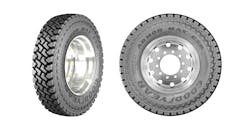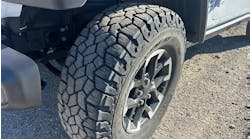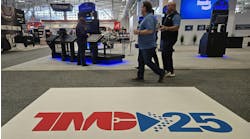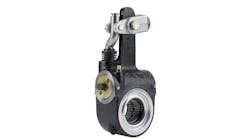Vocational trucks get rugged boost with Goodyear Armor Max ESD tire
Because retreading is more important than ever to improve tires’ total cost of ownership, Goodyear has engineered the Armor Max Extreme Service Drive (ESD) tire, which was specifically designed to stand up to the rigors of heavy-duty construction, logging, oil, and mining jobsites, with a tread compound that resist cuts, chips, and tears. Available in 11R22.5 H and 11R24.5 H sizes, these premium tires feature an optimized tread geometry to prevent stones from lodging in the tire, while the enhanced under-tread provides protection against stone drilling. Both improve casing durability and the potential for retreading. Furthermore, the 32/32" tread design ensures minimized mud and snow buildup for enhanced off-road traction, while the sidewall design allows chains to be placed above tread blocks, minimizing slippage.
For more on these tires, we spoke with Jessica Julian, commercial product marketing manager at Goodyear North America.
Fleet Maintenance: What are some key points to know about the Armor Max Extreme Service Drive tire?
Jessica Julian: We've optimized the tread geometry, changing the way the tread blocks are shaped. Think of it as going from a ‘V’ to a ‘U’ shape. That keeps the stones and the gravel and mud from staying in that tread. Then, our engineers also added penetration protectors, which are little like nubs which also help eject stones. Finally, we enhanced the under tread, which is another layer of protective rubber. All of those thing helps protect that casing and protect the investment for the fleet.
And the aggressive tread really gets you out of those sticky situations in the mud or out of the mine, where there's big gravel and rocks. You really need that meat on those tires.
FM: Who will benefit the most form using the Armor Max ESD tire?
JJ: When you think about Armor Max, think about more durability and traction. That's why a fleet is going to want to put that on their vehicle. Think of construction, fleets, logging, mining—anywhere where there's more off-road than on-road with gravel and mud. You don't want to get stuck or have tire failures when you're in those particular vocations.
FM: Why was this tire developed?
JJ: We had noticed that there was a lot of issues across the industry with the casing being damaged. If a fleet buys a tire, they want to be able to retread it; they want to get as many cycles as they can out of that casing. If the casing is damaged and it can't be repaired, that costs the fleet more money. And in off-road vocations, you're just beating the snot out of your tires. A stone gets lodged in the tread, and if it's not able to fall out, every time the tire rolls over something else, like another rock, it's just pushing that stone deeper and deeper into the tread to the point where it will go into the casing and puncture those steel belts.
So, Goodyear took all that data and went to the drawing board, and we set about answering how we can improve this for fleets. The initial feedback was it reduced stone holdings significantly enough to where I think that fleets are really going to take note of this and see a big improvement in their return ability of the casing.
FM: What else should we know?
JJ: The Armor Max ESD is part of Goodyear’s Total Mobility platform. We have our trusted product, the tire, and then we have our nationwide network to assist if there are any maintenance issues that are needed with that tire. There’s also our total solutions. That includes tire pressure monitoring, the CheckPoint drive-over reader, and TireOptix handheld device. We all know how important it is to keep your tires inflated—how it affects the fuel consumption. And having the incorrect tire pressure in a tire can also damage the casing. So it's all of these things that play into a fleet’s total cost of ownership. If you pay a premium price for a tire, but then you're not maintaining it, then you're just wasting your money.




